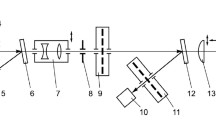Abstract
This article presents the fundamentals of the identification of spatial distributions of laser beam intensity. This identification is essential for the certification of laser sources. The identification objective consists of the assessment of the distribution similarity of the radiated field intensity with a given (calculated) distribution. A methodology for identifying spatial distributions of laser beam intensity is proposed. A mathematical apparatus based on functional inequalities is developed to form similarity measures of the intensity distribution of a radiated field with an arbitrarily given distribution. Various similarity measures are considered, and several spatial intensity distributions are compared with Gaussian and uniform intensity distributions depending on the dynamic range of the identification tool. The sensitivity of similarity measures to the intensity distribution shape of the radiated field is revealed. Such well-known characteristics as the aberration factor and propagation coefficient of the laser beam are special cases of measures based on solutions of functional inequalities.


Similar content being viewed by others
References
Yu. A. Anan’ev, Opticheskie Rezonatory i Lazernye Puchki [in Russian], Nauka Publ., Moscow (1990).
I. S. Matsak, E. M. Kudryavtsev, and V. Yu. Tugaenko, “Modeling diameter measurement errors of a wide-aperture laser beam with flat profile,” Comput. Res. Model., 7, No. 1, 113–124 (2015). https://doi.org/10.20537/2076-7633-2015-7-1-113-124
I. S. Matsak, V. Yu. Tugaenko, and E. S. Sergeev, Meas. Tech., 57, No. 6, 651–657 (2014). https://doi.org/10.1007/s11018-014-0514-0
Xing Ji-chuan, Song Yan, Proc. SPIE - International Soc. Opt. Eng., (2012). https://doi.org/10.1117/12.976829
A. M. Raitsin, M. V. Ulanovskii, Meas. Tech., 58, No. 6, 630–633 (2015). https://doi.org/10.1007/s11018-015-0766-3
V. M. Kasparov, A. M. Raitsin, and M. V. Ulanovskii, Meas. Tech., 59, No. 10, 1078–1083 (2017). https://doi.org/10.1007/s11018-017-1095-5
A. M. Raitsin, Meas. Tech., 54, No. 2, 162–169 (2011). https://doi.org/10.1007/s11018-011-9700-5
D. A. Bezuglov, S. A. Shvidchenko, “Kumulyantnyi metod opredeleniya zakona raspredeleniya,” H&ES Res. – Naukoemk. Tekhnol. Kosmich. Issled. Zemli, No. 1, 11–14 (2011).
Ya. Z. Tsypkin, Informatsionnaya Teoriya Identifikatsii [in Russian], Nauka Fizmatlit Publ., Moscow (1995).
A. A. Gulamov, “Formirovanie supergaussovykh puchkov,” Uchen. Zapiski, Elektron. Nauch. Zhur. Kursk. Gos. Univ., No. 1, 59–70 (2006).
A. K. Potemkin et al., Quantum Elec., No. 35 (11), 1042 (2005). https://doi.org/10.1070/QE2005v035n11ABEH012788.
Author information
Authors and Affiliations
Corresponding author
Additional information
Translated from Izmeritel’naya Tekhnika, No. 4, pp. 30-36, April, 2022.
Rights and permissions
Springer Nature or its licensor (e.g. a society or other partner) holds exclusive rights to this article under a publishing agreement with the author(s) or other rightsholder(s); author self-archiving of the accepted manuscript version of this article is solely governed by the terms of such publishing agreement and applicable law.
About this article
Cite this article
Raitsin, A.M., Ulanovskii, M.V. Bases for the Identification of Spatial Distributions of Intensity Laser Beams. Meas Tech 65, 258–265 (2022). https://doi.org/10.1007/s11018-022-02077-6
Received:
Accepted:
Published:
Issue Date:
DOI: https://doi.org/10.1007/s11018-022-02077-6




